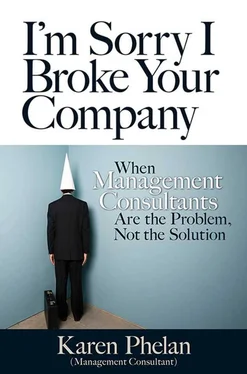Karen Phelan - I'm Sorry I broke Your Company
Здесь есть возможность читать онлайн «Karen Phelan - I'm Sorry I broke Your Company» весь текст электронной книги совершенно бесплатно (целиком полную версию без сокращений). В некоторых случаях можно слушать аудио, скачать через торрент в формате fb2 и присутствует краткое содержание. Город: San Francisco, Год выпуска: 2013, ISBN: 2013, Издательство: Berrett-Koehler Publishers, Жанр: management, popular_business, на английском языке. Описание произведения, (предисловие) а так же отзывы посетителей доступны на портале библиотеки ЛибКат.
- Название:I'm Sorry I broke Your Company
- Автор:
- Издательство:Berrett-Koehler Publishers
- Жанр:
- Год:2013
- Город:San Francisco
- ISBN:978-1-60994-740-8; 978-1-60994-741-5
- Рейтинг книги:3 / 5. Голосов: 1
-
Избранное:Добавить в избранное
- Отзывы:
-
Ваша оценка:
- 60
- 1
- 2
- 3
- 4
- 5
I'm Sorry I broke Your Company: краткое содержание, описание и аннотация
Предлагаем к чтению аннотацию, описание, краткое содержание или предисловие (зависит от того, что написал сам автор книги «I'm Sorry I broke Your Company»). Если вы не нашли необходимую информацию о книге — напишите в комментариях, мы постараемся отыскать её.
I'm Sorry I broke Your Company — читать онлайн бесплатно полную книгу (весь текст) целиком
Ниже представлен текст книги, разбитый по страницам. Система сохранения места последней прочитанной страницы, позволяет с удобством читать онлайн бесплатно книгу «I'm Sorry I broke Your Company», без необходимости каждый раз заново искать на чём Вы остановились. Поставьте закладку, и сможете в любой момент перейти на страницу, на которой закончили чтение.
Интервал:
Закладка:
A metrics scorecard acts like a car's dashboard. Executives monitor progress with large meters and are notified of problems when small warning lights turn red.
The rise of information technology during this same period made the data collection and reporting needed for this whole measurement and monitoring system much easier to implement. It started with executive dashboards that showed progress toward key metrics. Then IT worked It's way into employee performance appraisals with the development of automated performance management systems driven by SMART (specific, measurable, actionable, results-oriented, and time-bound) goals and metrics that linked upward and downward. As executive dashboards became popular, businesses wondered why they should be limited to executives, and with web technologies, any employee or department could have It's own dashboard to monitor measures. These web pages look a lot like the control panels used to monitor machines, with red alerts, yellow caution signals, and green icons meaning «on-track.» Now executives and managers could see exactly what was going on without ever having to leave their desks or talk with anyone. They could manage everything with a simple, color-coded web interface. Just like statistical process control, it was a perfect command-and-control system with warnings whenever any of the measures went «off-spec.» What could possibly be wrong with that?
The problem is that the system is trying to command and control an organization composed of people. And the problem with people is that, well, we re people. We don't operate like machinery. In fact, we really don't like being commanded or controlled, and our reactions to these measurement systems cause our behaviors to change in unpredictable ways. One thing I have learned from these measurement systems is that if you pick a specific goal and attach rewards and punishments to it, you can pretty much guarantee that somehow that goal will be met. Unfortunately, this often comes at the expense of other worthy, but nonmeasured, business goals. The most straightforward example, and the place where numerical targets got their start, is in sales organizations. Today, most companies have moved away from paying their sales representatives straight salaries to offering commission-based compensation, that is, the more a person sells, the more he makes. Typically, a salesperson has quarterly revenue targets to meet to get the incentive compensation. Anyone familiar with sales knows that sales usually pick up at the end of each quarter and then drop off at the beginning. This is because salespeople offer promotions and other incentives, like rebates, to their customers to order before the close of the quarter. Of course, promotions and rebates harm profitability, but most salespeople aren't measured on profits, so they don't care.
Sales representatives often game the system to their advantage. Probably the worst example I have ever seen was when a regional manager got fed up with the unachievable revenue targets he was given every year. Not only did he not get a bonus, but all the members of his team were penalized in their compensation. It's one thing to suffer the penalty yourself, but having to inform the hardworking people on your staff year after year that they didn’t make the cut can be heart wrenching. One year, he persuaded his distributors to buy more product than they wanted so he and his team could meet their year-end sales goals. He promised that they could return what they didn’t sell. He and his team met their targets and got their bonuses, and the company was flooded with returns two quarters later. (He had already planned his resignation.) Besides having to write off most of this product, a huge cost, the company also had to pay for the extra handling and storage and the bad will that resulted from this scheme. Of course, in this managers defense, the sales targets he was asked to meet had no grounding in reality but were the result of an executive’s desire for double-digit growth in a stagnant market. Somewhere at the root of this thinking was a consultant’s advice that stretch goals would spark creativity in meeting them. (I used to say this. I’m sorry.) They certainly did!
The games people play in meeting their targets are widely documented in business literature. Here is just a small sampling of examples:
• Perhaps the most famous case is the Sears auto repair scandal. The state of California charged Sears auto centers with fraud after Sears instituted incentive compensation schemes based on sales targets for certain parts and services. The result was that customers had unnecessary repairs done on their cars without their consent or knowledge. Needless to say, the company’s business suffered as a result of the customer fraud.
• Reengineering the Corporation relates an anecdote about the IBM credit department that had reengineered It's processes and set performance standards for each step. Although it was getting 100 percent compliance with the targets, the lead time to process a credit application had actually increased. When workers were in danger of missing their volume targets, they returned bids to the senders when they found typos or other errors instead of just correcting the errors themselves.
• Among the examples Jeffrey Pfeffer writes about in an HBR article on pay myths is Highland Superstores. After Highland instituted commission targets for the sales staff, the resulting behavior of the salespeople was so aggressive that it alienated customers.
• Gregg Stocker, in his book Avoiding the Corporate Death Spiral, has identified an obsession with numbers as one of the steps in the spiral, and among the examples he gives are a public transportation authority and a post office. The transportation authority decided to align the pay of bus drivers with their on-time arrival rate. As a result, drivers skipped stops if they were running late, leaving passengers stranded. A post office that instituted targets for mail processing times found numerous bags of undelivered mail hidden away. When workers couldn’t process all the mail within their targets, they just hid the mail.
• In «Paying People to Lie,» Michael Jensen writes about numerous cases of deception and fraud in meeting sales targets, including a software company that was cited by the Securities and Exchange Commission for backdating sales, booking maintenance agreements as software sales, and paying fictitious consulting fees to customers in lieu of giving them product refunds.
• More recently, a federal investigation on fraud in home foreclosures cited that performance measures contributed to «robosigning,» where foreclosures were processed without being read or having the proper documentation. How many people lost their homes as well as their life savings because bank staff were under pressure to process a target number of foreclosures?
These are the worst-case examples where people resort to deception and fraud to meet targets. Not everyone will stoop so low, but I have noticed that people will often manipulate the measures to meet them. For example, as a frequent flier for most of my life, I noticed that about a decade ago, stated flight durations lengthened. This coincided with industry-wide measures of on time arrival. When I first started flying decades ago, a flight was never early. It was either on time or late. Now it is commonplace for flights to arrive thirty to forty-five minutes early , which initially seems like a good thing. However, if you've arranged for a ride to pick you up at the arrival time, you could be waiting around the airport for a while.
In another example, I worked for a corporate department that conducted annual customer satisfaction surveys. For years, we had shown steady improvements. After a while, our service levels plateaued. Even though the satisfaction level was still high, the leadership team was under pressure to show continuous improvement. The answer was to count all the «neither approve nor disapprove» answers on a feedback survey as positive responses, showing a nonexistent improvement over the prior year.
Читать дальшеИнтервал:
Закладка:
Похожие книги на «I'm Sorry I broke Your Company»
Представляем Вашему вниманию похожие книги на «I'm Sorry I broke Your Company» списком для выбора. Мы отобрали схожую по названию и смыслу литературу в надежде предоставить читателям больше вариантов отыскать новые, интересные, ещё непрочитанные произведения.
Обсуждение, отзывы о книге «I'm Sorry I broke Your Company» и просто собственные мнения читателей. Оставьте ваши комментарии, напишите, что Вы думаете о произведении, его смысле или главных героях. Укажите что конкретно понравилось, а что нет, и почему Вы так считаете.












